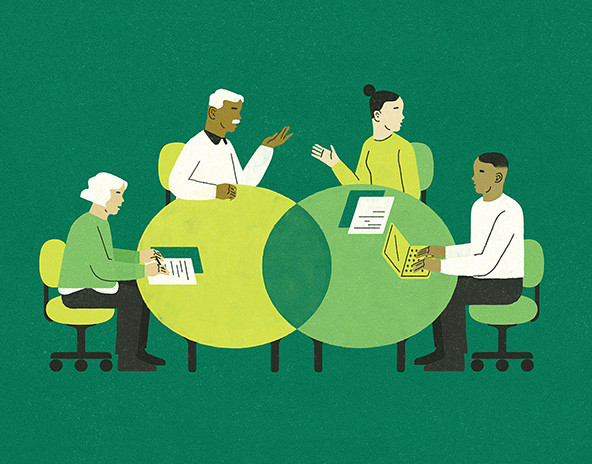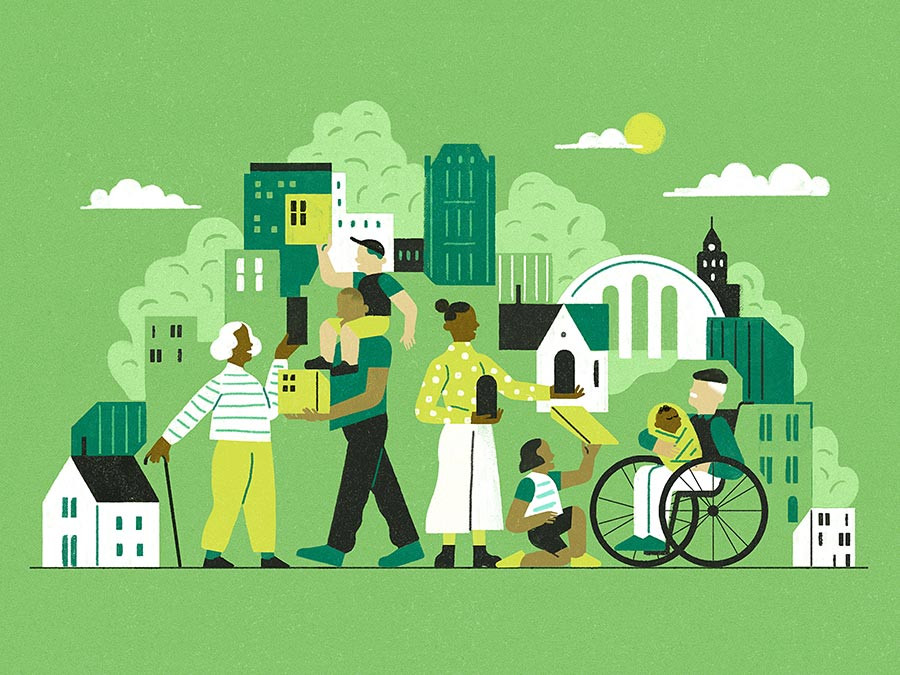 (Illustration by Gracia Lam)
(Illustration by Gracia Lam)
Many experienced professionals want to continue working in the years and even decades that follow the traditional retirement age. They want to stay engaged and productive and, in many cases, need to keep earning income. Many also want to apply their skills to new roles that have greater personal meaning and social impact. Indeed, Stanford researchers discovered that 31 percent of adults between the ages of 50 and 92—some 34 million people—“identify, prioritize, adopt and actively pursue goals that are both personally meaningful and contribute to the greater good.”
At the same time, nonprofits need workers with experience in areas like technology, marketing, strategic planning, and fundraising, but often struggle to find or afford suitable candidates. They also stand to benefit from workers who have resilience, judgment, communication, and problem-solving skills—traits that studies show older employees can bring. Given the prevalence of younger nonprofit employees (48.4 percent are under 40) and staff new to leadership roles in the sector, experienced professionals can also serve as mentors.

Putting Tested Skills to New Use
The concept of “recycling” corporate experience to benefit good causes and new generations of leaders isn’t new. Experienced leaders have long served as advisers and board members for schools and charities. In 1964, SCORE was among the first nonprofits to bring the expertise of retired corporate talent to small business entrepreneurs in need of mentors. And in 1978, a group of corporate leaders in Chicago founded the Executive Service Corps to bring corporate expertise to the nonprofit sector. Today, the group’s members provide free or low-cost consulting, coaching, and facilitation services to some 150 nonprofit organizations.
Since then, colleges like the University of Minnesota Advanced Careers Initiative have created programs to help retired professionals find new purpose, community, and social-impact employment while age-integrating higher education. Others, such as Ageless Innovators and CIRKEL, provide co-mentoring opportunities that bridge generations with the goal of boosting careers.
At Encore.org, a nonprofit dedicated to connecting people across generations, we created the Encore Fellows program to match experienced professionals at the end of their careers with nonprofits in need of their skills and talent. This midlife internship program intentionally age-integrates the nonprofit sector, benefiting older professionals seeking second careers, younger colleagues, and their organizations.
Encore Fellows typically receive stipends of between $20,000 and $25,000 (based on regional variations) for 1,000 hours of work over a period of up to a year. Over the years, several corporations have covered the costs of an Encore Fellowship for retirees or for employees leaving the companies during layoffs or restructuring. Nonprofits, and occasionally foundations, have paid the costs for other fellows.
Since its inception in 2009, more than 2,000 people have served as fellows in 50 metropolitan areas across the United States, providing more than 2 million hours of service at a fraction of their market value. The program has succeeded in providing a transition to the nonprofit sector. About 60 percent of fellows stay on at their host nonprofit in some capacity—as staff, consultants, or board members—and some continue working there for years.
For example, after a 23-year career at Hewlett-Packard, including a job as vice president of executive services and compensation, James Otieno joined the Silicon Valley Education Foundation as one of the very first Encore Fellows. When his fellowship ended, then-CEO Muhammed Chaudhry hired him as vice president of partnerships, strategy, and technology. Otieno “walks on water,” Chaudhry told the Mercury News. Otieno worked for several years at the nonprofit, leading efforts to build a five-year strategic plan and often mentoring his boss and younger colleagues. When he left, he started his own foundation to create educational opportunities for women and children in his native Kenya and neighboring Sudan.
Scaling Age Integration in the Social Sector
Done well, organizations looking to add age diversity or start their own age-integrated program can not only increase organizational performance, but also chip away at age bias and increase racial diversity. And by building in flexibility and openness toward new solutions, they can position age-integration initiatives to scale. Here are five insights from our work.
1. Multigenerational teams benefit all kinds of organizations. Most formal diversity, equity, and inclusion programs don’t include age diversity as a goal. But the value of multigenerational teams is becoming increasingly clear. A recent AARP survey of 6,000 global employers, for example, found that “83 percent of business leaders say multigenerational workforces are key to the growth and long-term success of their companies.” And, according to an analysis in the journal of the American Psychological Association, managers surveyed by the Society for Human Resource Management reported that age diversity positively contributed to organizational performance. As business journalist Jonathan Burton wrote in MarketWatch earlier this year:
Older workers are highly valuable. They bring judgment, balance and perspective to an organization. They tend to stick around longer than their job-hopping, ladder-climbing counterparts. Older employees typically aren’t angling for promotions and view younger co-workers not as threats but as mentoring opportunities. Moreover, research shows that when a company facilitates the exchange of ideas and initiatives across generations, its productivity, profitability and worker morale all improve.
Even at organizations where profit isn’t the bottom line, multigenerational teams prove valuable. One reason is that learning travels up and down the age ladder. When Encore Fellow Kathleen Kostrzewa joined the EnCorps STEM Teachers Program last year, for example, she brought corporate IT and business development experience—plus age diversity. “Kathy has decades of experience and offers our team sage advice and a different perspective,” said 34-year-old Bethany Orozco, the group’s national recruitment and communications director. “She’s been able to help us take a step back, think more strategically, and standardize processes and procedures.” Kostrzewa meanwhile said of her younger colleagues, “[They] keep me up to date [and] help me stay sharp.”
2. Ageism remains a barrier, even in the nonprofit sector. In the United States, a 2018 survey found that 61 percent of adults over 45 have either seen or experienced age discrimination in the workplace. And a survey of more than 83,000 people in 57 countries released last year reported, “One in every two people held moderately or highly ageist attitudes.”
The nonprofit sector is hardly immune. While we have yet to encounter a nonprofit leader who says they’re not interested in adding older workers to their teams, we have talked with many who express concerns about older workers that reflect ageism. These include doubts about their technology skills and ability to listen and learn, and the alleged awkwardness of supervising employees decades older than themselves.
Nonprofit leaders also frequently assume that older employees—particularly those whose primary work experience has been in the for-profit sector—won’t fit in. This creates a hard sell, both for potential sponsors of fellows and for nonprofits who could benefit from working with them. We counter with stories of the many fellows who fit in just fine, testimonials from the leaders who hired them, and this finding: Ninety-five percent of all hosts say that Encore Fellows “contributed valuable ideas, tools, and expertise.”
3. Generic outreach doesn’t yield racial diversity. Candidates for Encore Fellowships originally came primarily through tech companies that offered the fellowship as a retirement benefit. As one might expect, the pool of older tech employees was and remains largely white and Asian American, just as the majority of people interested in becoming an Encore Fellow have been. In earlier days, we never stressed to our corporate supporters the value—to both employers and the program—of finding ways to appeal to retirees of color. If we had been intentional about racial diversity from day one, our pool of participants would be much more diverse than it is now, but we are making progress.
Today, we are committed to pursuing diversity in fellowship applicants and host organizations. We now have a more racially diverse staff and are reaching out to organizations led by people of color to build relationships. We are also emphasizing to funders that we are interested in placing fellows of color within diverse grantee organizations. And we are designing fellowships that address issues faced by communities of color.
We recently designed a fellowship, for example, to help AARP increase its presence in the African-American community, and it selected Harriette Cole, an African-American journalist, author, and coach, to develop and implement programs aimed at this audience. “Harriette has quickly become an entrenched, valuable member of our team,” said Edna Kane-Williams, AARP’s senior vice president of multicultural leadership. “Her insights and knowledge about public relations and communications strategy have really helped us raise the bar on the reach and impact of our work. We’re truly honored to have someone of her caliber working with us. What a gift!”
4. Flexibility around the edges can pay off. Based on lessons learned from Dennis Wagner and the 100,000 Lives Campaign, the Billions Institute trains social sector leaders to "be tight on aims, loose on everything else." Building a multigenerational talent force can help make the social impact sector more resilient and scalable, but getting there requires flexibility.
The pandemic is a case in point. When COVID-19 hit, we introduced shorter fellowships, offering nonprofits Encore Fellows who could work as few as 250 hours (instead of the more-typical 1,000 hours) at reduced rates. We also offered fellowships that were 100 percent virtual. This strategy was necessary to protect fellows from exposure to the virus, but it also allowed us to find the best talent available anywhere for each role. As a result, we placed almost as many fellows in 2020 as we have in past years.
5. Innovation should pursue not one, but many paths. We are constantly seeking new ways to deploy fellows to help solve problems in the nonprofit sector. While our current model has proven effective, it’s limited in some ways. We need to ask: Would a model that offered experienced and talented people shorter-term fellowships but without a paid stipend succeed? Are there new, entirely pro-bono, models for deploying experienced talent against urgent social needs that could be equally attractive and impactful? What about a program defined at the start as intergenerational, recruiting both younger and older professionals to work together on a common cause?
Some of the questions we’ve asked have provided great starting points for new initiatives. For example: Can Encore Fellows help nonprofits tap the talents of more staff and volunteers over 50? We partnered with the Alliance for Strong Families and Communities to find out, placing Encore Fellows in Alliance member organizations to focus on recruiting. Can Encore Fellows make a difference in city hall? We partnered with the City of San Jose, placing Encore Fellows in city government to find new ways to bring generations together. Most recently, an Encore Fellow was instrumental in helping the city launch a mentoring program in which older adults match underserved youth between the ages of 14 and 29 with young professionals for career conversations.
Conclusion
Nonprofits’ growing interest in older adults moving into roles that take advantage of their talent, perspectives, and experience will likely lead to more age-integrated workplaces. The benefits for older adults new to the sector, the younger adults already in it, and the people they serve are clear.
We will continue to explore options for tapping the talents of older adults who want to make a difference while age-integrating the nonprofit sector. And we encourage other nonprofit organizations that could benefit from the addition of experienced staff to do the same.
Support SSIR’s coverage of cross-sector solutions to global challenges.
Help us further the reach of innovative ideas. Donate today.
Read more stories by Jim Emerman, Gina Cassinelli & Greg Burnett.

